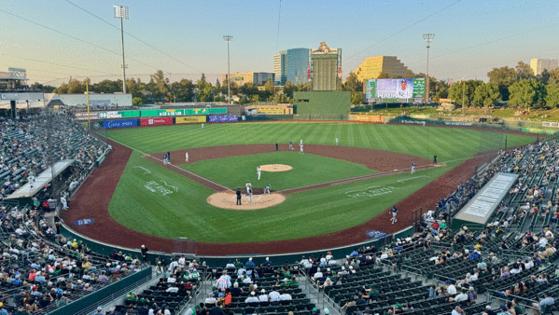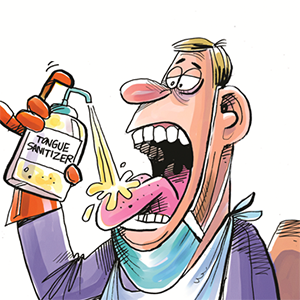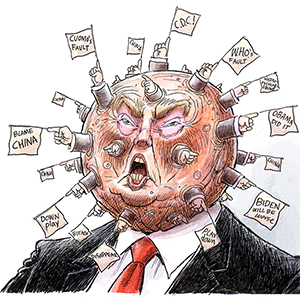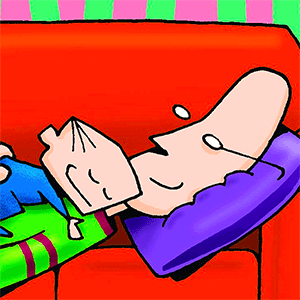Like Rays, A's find life interesting playing in a minor league stadium
Published in Baseball
WEST SACRAMENTO, Calif. — Any discussion about why the Rays are playing this season at the Yankees’ spring training and Class A minor league home, Steinbrenner Field in Tampa, is usually resolved by the most basic explanation of the damage Hurricane Milton caused to Tropicana Field last year:
An act of God.
But conversations about why the Athletics are playing this season at the minor league park that also houses the Giants’ Triple-A affiliate, the Sacramento River Cats, with plans to stay two more years while their new stadium is built in Las Vegas, tend to be more convoluted and characterized by some as the product of a different motivation:
An act of greed.
After working out a deal to move the A’s to Vegas in 2028, owner John Fisher needed to find a temporary home for the team. Unable, or unwilling, to work out a lease extension to stay at the Oakland Coliseum or to work out a way to play at the Triple-A stadium in Vegas, Fisher found a willing partner 86 miles away.
Sacramento is California’s state capital, but sports-wise it had only the NBA Kings, joining Orlando as the only top-20 media markets with one major pro franchise. It wanted to raise its profile, hopeful of staking for future Major League Baseball expansion.
All of which led to Rays starter Ryan Pepiot having to take a long, lonely trek across the Sutter Health Park outfield grass to the visitors clubhouse shortly after being taken out of Monday’s game in the seventh inning.
“The walk of shame sucks,” Pepiot said.
Like the Rays at Steinbrenner Field, the A’s, with input from MLB, did the best they could to make a minor league field look and feel like the majors.
A two-story building was constructed that included a new home clubhouse with rooms for trainers, weights, coaches, eating and meetings. Other spaces were upgraded, better in some ways than what the A’s had in Oakland. The playing surface was improved to be able to handle hosting 156 games between the two teams, and the A’s scheduled to play mostly at night to avoid the heat. They replaced the scoreboard and batter’s eye, and freshened up whatever else they could.
“It’s been pretty much everything I could have expected,” A’s outfielder Lawrence Butler said Monday. “I wasn’t coming in here expecting a big league field or big league stuff because, I mean, it’s not a big league field. So it was pretty much what I expected. It’s actually not too bad.
“When we went (to Tampa), I would say our setup is better than theirs. So it kind of made me a little bit thankful for what we do have.”
Comparisons by the players are a bit skewed, because for the most part they only see the home facilities at their stadium and the visiting setup when on the road.
The visiting accommodations at Steinbrenner are somewhat basic (a large photograph of the damaged Trop on the clubhouse wall serves as a subtle reminder of the circumstances) and spread out among several locations. But Rays players rave about the home side, which had just been significantly upgraded, expanded and enhanced for the Yankees, to the point of it being better than some regular-season stadiums.
“As far as our home-side stuff goes here, it’s great,” A’s All-Star Brent Rooker said. “This building is great. All our facilities are exactly what we need. From a visiting perspective, I think the feedback that we’ve gotten from teams has been positive overall.”
Plus, Rooker said, his teammates have handled it well.
“I’ve been proud of our guys and how we’ve adapted and adjusted to the challenges and the changes and all the obvious stuff. Overall, I think we’ve done a good job.”
What the A’s couldn’t do was address what stands out as by far the biggest issue — the clubhouses being situated beyond the outfield fences rather than under the stands and connected to the dugouts as in other big league stadiums.
So when Pepiot was taken out of Monday’s game after turning a good outing “into kind of a crappy day,” allowing two seventh-inning singles then a three-run homer that cut the Rays’ lead to two in an eventual 7-4 win, he couldn’t take out his frustrations privately in the tunnel or stairs leading back to the clubhouse. Instead, he had to do so heading in full view to a gate in the center-field fence that can only be opened between innings.
With the batting cage in a building adjacent to the clubhouse, there can be some strategic implications in trying to get a pinch hitter ready. Players can’t just go to the clubhouse between innings to escape the heat or pop into the trainer’s room.
Tyler Wall, the Rays director of equipment and clubhouse operations, had to make a mad dash earlier in the game from the dugout to the clubhouse and back when new outfielder Everson Pereira needed a new belt.
But Pepiot, one of five current Rays who played in Sacramento as minor leaguers, said the overall upgrades were done well.
“On the inside, they redid everything. It’s a little bit of a maze in here trying to figure it out. The clubhouse guys did a good job of giving everyone a tour to figure out where they had to go,” Pepiot said.
“But they really did a good job with the locker room, the training room, the gym. It’s completely different. When I was here (before), I think we were lifting (weights) outside, had a deadlift bar outside, strapping weights and stuff and bands to the back side of the fence, just trying to get in whatever you could while you’re here.”
Like Steinbrenner Field, Sutter Health Park tends to favor hitters, with homers soaring out. Also, without a third deck, wind is more of an issue at times.
Rays manager Kevin Cash, who played two games in Sacramento in 2011 during his final pro season, said the field and the facilities were fine. And having a couple of food trucks (tacos and kabobs on Monday) in addition to the usual clubhouse spread was a good touch.
“What they’ve done looks very nice,” Cash said. “The clubhouse is super manageable. The food’s been good, so I think the guys are fine. If you can get the food right, most players are going to be happy.”
There have been some complaints about the playing conditions, including from A’s pitcher Luis Severino, who was happy to sign a three-year, $67 million contract before doing so. Phillies and Twins pitchers took issue with the mound being too hard, suggesting it could lead to injuries. There was some similar chatter about the batter’s box.
Cash said after Monday’s game the Rays had no issues.
“The field was great,” he said. “The surface was really good, a firm surface. You can tell the ball flies here a little bit. Give the grounds crew credit.”
The A’s made some interesting decisions related to the move, most notably to call themselves just the Athletics (or A’s) and not take Sacramento as a first name.
They do wear a uniform arm patch and sell some merchandise that says “Sacramento” and features the iconic Tower Bridge. On the other sleeve, they wear a patch that says “Las Vegas” as the product of a marketing agreement with the Las Vegas Convention and Visitors Authority.
Fans have had somewhat of a mixed reaction to the A’s arrival. They have had seven crowds — for the Yankees, Giants and Cubs — pushing the 12,000-plus capacity but overall are drawing less than the Rays in their 10,046-seat home. The Rays are averaging 9,866, the A’s 9,658. Monday’s announced crowd of 7,731 was the A’s smallest of the season.
“We are getting continual feedback on Sacramento and are doing our very best to address each of those pieces of feedback in real time,” MLB commissioner Rob Manfred said at the All-Star Game. “It’s not perfect. If I had a brand new, gleaming stadium to move them into, we would have done that. We need to get there, and we will continue to work to make it the best from both a competitive perspective and from the perspective of the players’ comfort.”
©2025 Tampa Bay Times. Visit tampabay.com. Distributed by Tribune Content Agency, LLC.







Comments